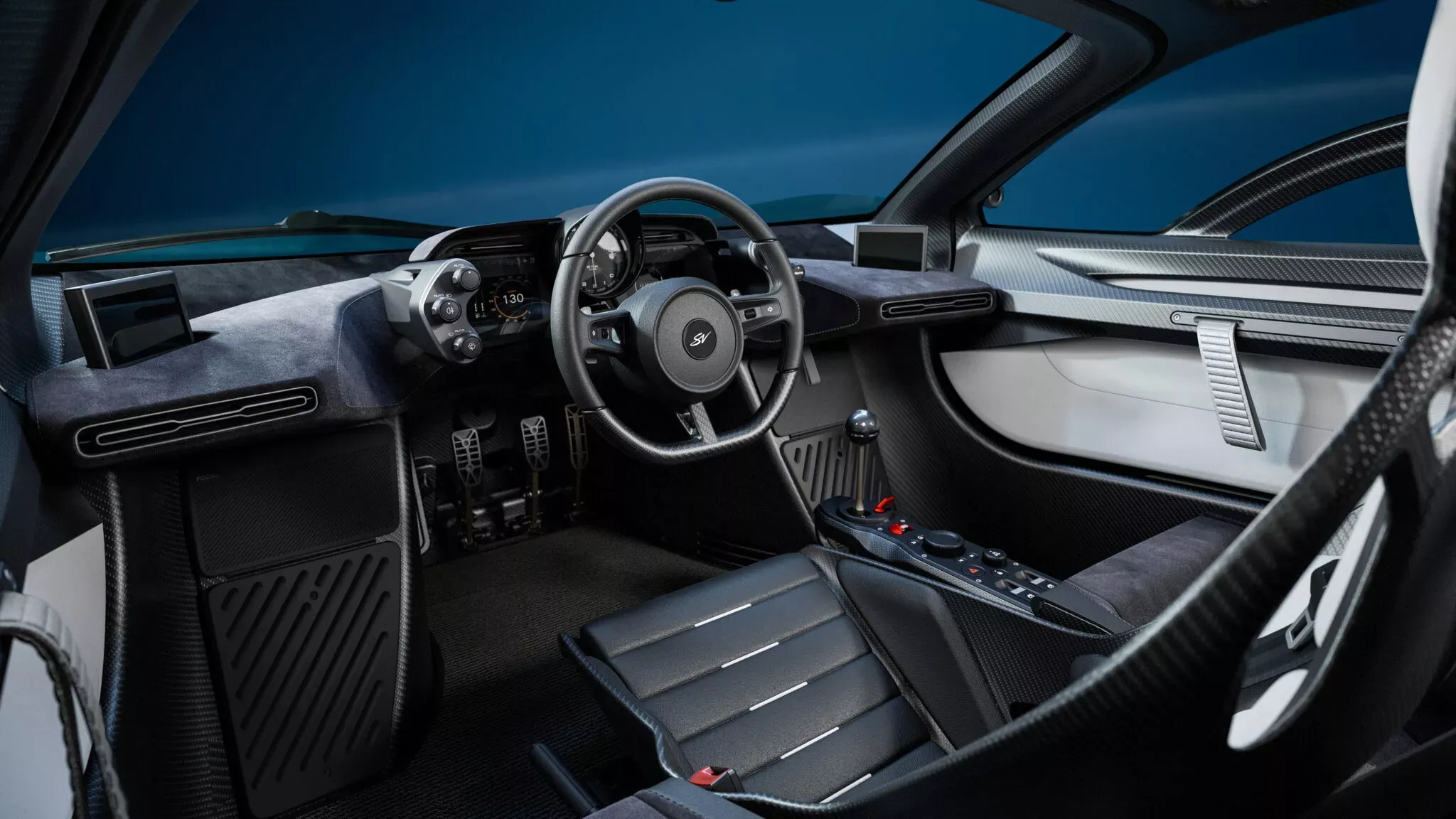The GMSV Le Mans GTR is the direct answer to the question every enthusiast asks: what would a long-tail racing car designed today by true engineering experts look like? Here’s the damn answer: V12 up to 12,100 rpm, 6-speed manual gearbox, and track-ready aerodynamics without any fluff.
What is the GMSV Le Mans GTR and why the hell does it exist?

This is the track-focused project from Gordon Murray’s Special Vehicles division, with a total emphasis on quick laps, consistency, and pure mechanical sensation. The core is the V12 from the GMA T.50—except everything else has been reworked for the track: lighter and stiffer suspension, wider track, larger tires, enhanced cooling, and optimized weight distribution.
The car was born from a direct request from a collector who loves rare, unfiltered machines. He asked, “What would you bring to Le Mans today?” The result is a modern longtail for those who believe a hypercar must sound loud, rev outrageously, and deliver authentic analog sensation—something in the spirit of the bare V‑12 manual from GP1.
How do the 12,100 rpm V12 and manual gearbox change the game?
The naturally aspirated V12 from the T.50 is a jewel: lightweight, hyper-responsive, with an obscene rev range for a modern car. In the T.50, it produces around 650 hp, serving here as a technical reference baseline—the calibration of the Le Mans GTR might vary because it’s a track machine. Check out the T.50’s specs directly from the manufacturer at Gordon Murray Automotive.
Combined with the 6-speed manual and gearing tuned for circuit rhythm, the setup prioritizes fine control and visceral feedback. It’s the opposite of the hybrid heavy wave—which is also incredible in its own right, like the electrified V12 in the Lamborghini Fenomeno—but here, the approach is rawer, more “driver-first, numbers later.”
What aerodynamics and chassis solutions deliver lap times?
The T.50’s fan takes a backseat. Instead, a classic, aggressive aero package is employed: a deep front splitter, side skirts, a dual-channel rear diffuser, and a full-width wing. The airflow is clean, progressive, and designed for high stability—precisely what you want when the straight ends and braking demands respect.

The chassis features lighter, stiffer suspension, wider track, and wider Michelin Pilot Sport Cup 2 tires—that, when heated, grip like hot glue. Want to understand why these tires are so damn good? Oh, and the RAM air intake on the roof fills the cabin with the glorious roar of the V12—just like a racing car should.
If you’re into hardcore aero on a homologated track machine, compare it to the extreme package of the Mustang GTD Liquid Carbon. It follows another philosophy but aims for the same goal: reduce lap times through downforce and thermal management.
How many units will exist, and how much does it cost to join this club?
There will be 24 units—one for each hour of the race that inspired the name. All already sold. Price? Not disclosed. In behind-the-scenes talks, it’s usually somewhere between seven and eight digits in dollars or euros, depending on specs and customization packages. If that hurt, welcome to the world of ultra-limited track specials.
The cabin has been redesigned for the track: reorganized dashboard, switches and gauges where they need to be, redesigned seats and pedals. You choose colors and materials without sacrificing function. Exclusivity is key here—just as collectible as the record setters everyone references, like the Koenigsegg Jesko Absolut in the speed war, but with a very pure, purist vibe.
How does it compare to racing rivals and electrified hypercars?
It’s not about 0–60 lightning quick. It’s about sensation, stint rhythm, and consistency. The Le Mans GTR plays in the “driver with their hands” field, while electric hypercars appeal to instant torque and heavy electronic management—all incredible, but with almost opposite philosophies.

For cross-reference: compare the brutal delivery of a track EV like the YangWang U9 Track Edition with the aspirated V12 longtail. One destroys the straight-line numbers. The other hypnotizes with feel and flow state. Choose your poison.
Quick technical highlights
- V12 up to 12,100 rpm
- 6-speed manual
- Deep front splitter, side skirts, and full-width wing
- Dual-channel diffuser
- Lightweight, stiff suspension
- Michelin Pilot Sport Cup 2 tires
- RAM air intake on the roof
- 24 units, all sold
Straight comparison (bullet points, no bullshit)
- Philosophy: purist vs hybrid/electric
- Feedback: analog vs digital
- Rhythm: long stint vs burst
- Sound: V12 scream vs silence+whistle
- Aero: classic longtail vs active
- Maintenance: handcrafted vs high-tech
Why does this longtail feel so “soulful” to drivers?
Because it’s lightweight, mechanical, and made to talk to you all the time. The RAM air intake on the roof plays the V12’s hymn directly into your helmet. The manual gearbox forces you to stay engaged every meter. And the aero doesn’t “solve” everything on its own—you still have to be the damn driver.

And if you want more references of machines that celebrate sound, revs, and tactile feel, check out another no-nonsense, aspirated V12 with a raw vibe: the GP1 garage-style also plays in this emotional arena, even with a different technical package.
FAQ — questions you’d likely have in your garage
- Is there intrusive electronic assistance? The focus is pure driving; electronics exist but don’t steal the show.
- Is it legal for the street? It’s a track-oriented proposal. Regulations may vary by market, but the idea here is a race track, period.
- Official power? Not disclosed. Use the T.50 (around 650 hp) as a technical baseline reference.
- Why no T.50 fan? The aero package here is classic racing, for stability and consistency.
- Can I customize? Yes. Colors, materials, and interior adjustments focused on track use.
Into track toys with strong visual appeal and clear purpose? Another great read is this extreme hybrid V12 beast from the house of bulls, with a flagship vibe: Lamborghini Fenomeno. It’s a different technical world, but the drama is just as delicious.
My take: the Le Mans GTR doesn’t aim to crush spreadsheets. It wants to melt your brain with the combo of sound+rev+precision. Forget about 0–60 numbers; it’s about curves. Designed for a select few, very few. The price in $/€? You already know: if you have to ask, it’s probably too late. And that’s okay—there’s still the thrill of hearing that V12 howl, and maybe aiming for a track toy that’s less extreme but still offers a fraction of that same thrill.
Liked the GMSV Le Mans GTR? Which part gave you chills—the 12,100 rpm V12, the manual, or the longtail aero? Leave a comment below and let’s swap ideas!








Author: Fabio Isidoro
Fabio Isidoro is the founder and editor-in-chief of Canal Carro, where he has been writing about the automotive world since 2022. Passionate about cars and technology, he began his journey on the HospedandoSites portal and today dedicates himself to creating technical content and comprehensive analyses of national and international vehicles. 📩 Contact: contato@canalcarro.net.br


